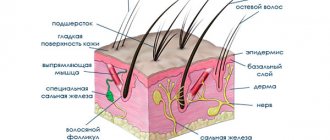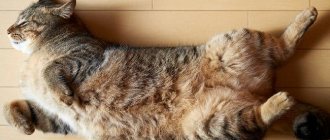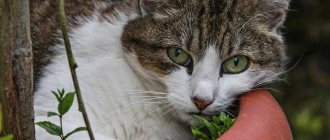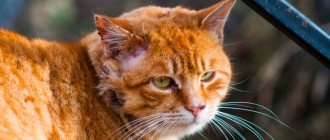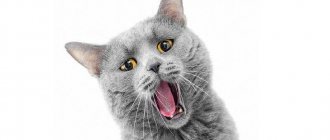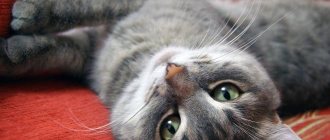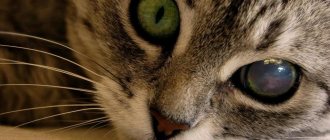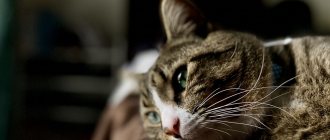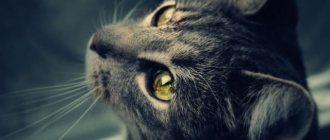Healthy cats spend many hours licking and biting their fur to remove dirt and debris. So, if your cat's fur is oily and matted, something is wrong. Behind the problem will be health problems, physical or emotional.
An obese or arthritic cat will be physically unable to groom, resulting in an oily, lumpy coat. Tooth pain will also make your cat reluctant to groom itself. Medical explanations include hyperthyroidism, diabetes and skin conditions. Additionally, lack of self-care may be an early sign of cognitive dysfunction.
An unkempt coat will bother your cat, so you should help with its daily grooming. You will also need to find out why your cat has oily and lumpy fur so that steps can be taken to correct the problem.
Obesity
As cats get older, they naturally become less active. Play is less attractive and cats are less interested in exploring wildlife and climbing trees. Cats prefer to find a quiet corner and sleep all day.
It's all part of the aging process, but it's important to monitor your older cat's BMI. If your cat exercises less but consumes the same amount of calories, weight gain is inevitable.
You will need to reduce your cat's caloric intake or promote weight loss. Obesity puts pressure on a cat's heart and joints. Additionally, the increased risk develops into feline diabetes. The Journal of Feline Medicine and Surgery considers older male cats to be at highest risk for diabetes.
© shutterstock
Any cat that is overweight can develop diabetes. This causes hormone fluctuations in the cat's body, leading to oily hair buildup. Even if your cat is not diabetic, being overweight will affect her ability to groom. Grooming is cardio exercise for cats. An overweight cat will quickly become exhausted and give up.
An overweight cat may also be physically unable to access certain parts of its body. Healthy cats are mobile and able to assume different body positions. Excess weight makes this impossible, so hard-to-reach areas of your cat's fur will become greasy and clumpy.
Dandruff is a common problem in cats
Despite the fact that cats are very clean animals, dandruff is quite common among them. This phenomenon may be completely natural, since animals constantly renew their skin. A small amount of dead skin flakes should not cause much concern; cats can easily cope with this problem on their own. But excessive formation of dandruff can be a signal to go to the veterinary hospital, as it indicates a pathology or disruption in the functioning of the body.
When pets get into trouble, our task is to help the purr
What is dandruff
First, let's figure out what cat skin is. It consists of 3 layers:
- epithelial is the top layer in contact with the environment;
- connective tissue dermis - the next layer in which hair follicles, skin glands, blood vessels and nerves are located;
- subcutaneous layer consisting of loose connective tissue, including fat cells.
The top layer performs a protective function and therefore requires constant updating. The keratinized particles of skin, saturated with fat, peel off from time to time in the form of scales in a small amount. These small, loose white flakes are dandruff. This is normal. But if the peeling process intensifies, the top layer ceases to perform a protective function. This should alert cat owners.
Small peeling areas of skin are normal in a healthy cat, which a clean animal can deal with on its own
Dandruff forms over the entire surface of the animal's skin, but the greatest localization is most often noticed in the back area near the tail and behind the ears. A large accumulation of dead skin flakes causes a lot of anxiety in a pet. You've probably noticed how a cat diligently and nervously begins to lick an itchy spot, sometimes trying to scratch it to feel relief. Excessive exposure can even cause wounds to form on the skin.
Excessive accumulation of dead scales on the skin is evidence of a malfunction in the cat’s body.
Signs of a problem
If you begin to notice the following signs, then your pet has a problem:
- a large accumulation of skin scales, mostly large, is noticeable on the surface of the fur;
- the cat constantly licks the problem area;
- the coat looks untidy;
- itching causes a constant desire to scratch the affected area;
- in advanced cases, hair loss and wound formation are possible.
Nervous scratching can cause wounds
Types of dandruff and places of its localization
Dandruff or, more correctly, seborrhea appears in cats regardless of age, gender or breed. Depending on the causes, dandruff can be dry or oily and accumulate in different parts of the animal’s body.
- Dry dandruff is tiny particles of epidermis that cover the cat's entire body. If you stroke your pet against the grain, the particles easily separate and swirl around like a snowball. Signs of dry seborrhea are:
- insufficient function of the sebaceous glands;
- dry skin and increased flaking;
- keratinization of the epidermis.
Dry seborrhea in a cat is the smallest particles of keratinized skin
- Oily dandruff is usually localized behind the ears or on the back in the tail area. If you scratch your pet in this place, a white or light beige coating will remain under the nails. The coat in such places looks greasy and unkempt. Signs of oily seborrhea:
- increased activity of the sebaceous glands;
- dead scales accumulate under the fur in a dense layer;
- wool gets dirty very quickly.
With oily seborrhea, the hair looks very untidy
It is easiest to detect dandruff in black cats.
Arthritis and joint pain
Older cats are at risk for developing osteoarthritis. This rigidity will result in the cat being unwilling or unable to groom. The Journal of the American Veterinary Medical Association found symptoms of arthritis in 90% of cats 12 years of age and older.
You may not immediately notice that your cat has arthritis. Cats are good at hiding discomfort. If a cat cannot walk without limping, it will choose not to move. The appearance of external signs of discomfort is considered by cats as weakness.
Arthritis cannot be prevented. Cats experience pressure on their joints when they are young and active. This eventually takes a toll on the body when collagen production slows down, so be sure to treat your cat's arthritis pain.
Massage your cat's joints and give her healthy supplements. Provide your cat with a soft, warm bed in which to relax and encourage her to move around.
Symptoms of the disease
Fat tails are much more common in male cats than in male cats. As noted above, animals with short fur are at risk, which complicates the diagnostic process. Let's try to find out what signs clearly demonstrate this disease:
- The epithelium at the base of the fur becomes lumpy, it flakes off and becomes covered with a thin crust of pus.
- The tail, most often at the junction with the body, is thickly covered with fat, which makes the fur begin to shine. The discharge cannot be washed off with shampoo or soap.
- If the disease progresses, the skin at the site of localization will be combed and covered with red pimples. This is how the animal tries to relieve the itching, but only spreads the infection through the skin.
- The area of “greasy” fur becomes exposed over time. This is due to the fact that the hairs gradually break off at their base.
- A symptom that the anus is inflamed may be uncharacteristic behavior when the cat crawls with its butt on the carpet, trying to release excess contents.
- Over time, brown spots may appear on your pet's tail; if left untreated, they will develop into a hard crust, tearing which the cat will injure itself.
Owners who notice that their animal has developed “greasy tail” syndrome should under no circumstances dismiss this problem, attributing it to seasonality or simply the cat’s untidiness. Most often, the true cause lies precisely in a serious illness that has just begun to manifest itself. If you react promptly, it will save a lot of hassle for both the owners and the cat.
Toothache
If a cat is experiencing toothache, it will not want to groom itself. A cat with dental problems, in addition to refusing to groom, will have the following symptoms:
- Reluctance to eat or drink
- Stained and discolored teeth
- Swelling around the mouth
- Black gums
- Bad breath
Take action at the first sign of toothache, as gum disease will be the cause of the problem.
If left untreated, gingivitis leads to periodontal disease. This will be permanent degradation of your cat's teeth that cannot be cured. The best you can achieve at this stage is pain relief. A cat with periodontal disease will have regular flare-ups, so grooming will stop and this will be the reason why the coat is oily.
Treatment options
Treating a cat's fatty tail is a long and tedious process. You need to start with a trip to the veterinarian, who will determine exactly what caused the disease and how to eliminate it as quickly as possible. Treatment, as a rule, is based on the fact that the pet begins to take baths more often. To do this, you need to buy special shampoos containing lactic acid. This will perfectly exfoliate harmful keratin accumulations and cleanse the skin, which will create the basis for subsequent therapy.
If the veterinarian determines that the greasy tail is caused by a hormonal disorder, then castration of the pet or medication to stop the production of sex hormones will be required. Excessive production of anal secretions is treated with rinsing. The specialist will clearly explain to the owners how this is done. If the disease recurs regularly, the anal glands can be completely removed surgically.
If the causes are caused by external irritants, then a complex of vitamins and a special diet are prescribed to strengthen the immune system. All this will help the cat become beautiful again, and its owner - calmer. If you ignore the fact that your pet’s tail becomes fat, then in the future this can lead to complete baldness, which will make the animal completely unsightly.
Depression
If your cat is withdrawn and refuses to eat, depression is likely. Depressed cats lose all interest in grooming themselves. Causes of depression in cats:
- Major Lifestyle Changes
- Missing former owner or other cat
- Chronic pain
- Boredom
- Loneliness
Don't wait until your cat's depression goes away, as there is no way to know how long it will take. Improve your cat's lifestyle with a range of incentives and make sure she sticks to a consistent routine.
Diagnostics: how is it carried out?
To decide on treatment tactics, the doctor must examine the animal’s sore spot.
A wet and greasy area on the tail that appears on a cat requires urgent contact with a veterinary clinic. The specialist examines the problem area and assesses the severity of the violation. In most cases, a diagnosis can be made and treatment can be selected after a visual examination and medical history. If this is not enough for the veterinarian, then laboratory and instrumental examinations are carried out, after which the doctor will tell you how and with what to treat the cat so that the tail becomes normal again.
Skin diseases
Cats can get fungal skin infections that damage their fur, such as ringworm and seborrhea. Fungal diseases are most common in outdoor cats. When a cat wanders outdoors, it may encounter other infected felines. These problems can cause cats to have oily fur.
© shutterstock
Diagnostic measures
Only a veterinarian can accurately answer the question of why the cat’s fur has become fat and what to do to restore it to its former beauty and healthy shine. Diagnosis of a suspected disease involves a preventive examination by a veterinarian. During this procedure, a specialist examines the pet and, if necessary, recommends passing appropriate tests. If, in addition to greasy fur, the cat's skin is flaky and itchy, or dandruff appears, he should also be shown to a dermatologist.
Parasitic infestations
A buildup of fleas and ticks will have a detrimental effect on your cat's coat. These parasites attach to your cat's skin, causing irritation. The cat almost constantly bites and scratches its fur in an attempt to relieve the itching. This will ruin the appearance of the fur, probably making it greasy.
Unfortunately, preventative treatments can also cause greasy and lumpy coats. This will happen due to the chemicals released by the medicine. The problem is usually limited to the shoulders where treatment is performed. If this happens, switch to another brand.
Parasites can also cause secondary health problems. Seborrhea can be caused by flea bites, as well as allergic reactions. This is one of the reasons why finding the right preventive treatment is so important.
The condition of the coat is an indicator of the health of the cat!
The condition of the coat is one of the main indicators of the functioning of a cat’s body. If it is shiny, looks neat, there are no brown spots or greasy deposits on it, the hairs are elastic and do not form bald patches when they fall out, the cat owner has no reason to worry. Any deviation from the norm, especially in combination with other pathological manifestations (for example, indigestion, loss of appetite, lethargy), should alert the owner of the animal and become the basis for a visit to the veterinarian.
Sometimes the unsatisfactory condition of a pet’s coat has nothing to do with its health. The cat's owner himself may be the culprit for its greasiness, tangling, and formation of tangles. If the animal's fur becomes greasy, the hairs get tangled and it generally looks unkempt, perhaps its owner is abusing water treatments, using the wrong shampoo, rarely brushing his tailed friend - in general, he is not properly caring for the cat's coat.
Hyperthyroidism
The risk of hyperthyroidism increases as cats age. Hyperthyroidism is a disease of the glands. The thyroid gland is located at the back of a cat's throat. This produces the hormone thyroxine-a, also known as T4.
If your cat lives with hyperthyroidism, thyroxine-a will flood the body. Since this hormone is linked to a cat's metabolism, too much of it will cause a number of side effects. This includes:
- Sudden and unexplained weight loss
- Increased thirst
- Bursts of hyperactive energy
- Diarrhea
These symptoms can be confused with other ailments. Therefore, it is worth paying attention to oily hair, which is the first sign of hyperthyroidism. If hyperthyroidism is diagnosed, your cat will require lifelong oral medications.
Causes of deterioration in wool quality
Negative changes in the coat include: hair loss, lack of shine, dryness/excessive oiliness, increased tendency to form tangles. Often the problems are a consequence of the “home” lifestyle:
- incorrect temperature conditions - this factor affects the metabolism and thermoregulation of the pet, making molting almost continuous, and new fur weak and sparse;
- nutrition – we are talking about an incorrect balance of proteins/fats/carbohydrates, vitamins/minerals. Also, the composition of the diet sometimes does not take into account features associated with the age and hormonal levels of the animal;
- stress – the cat may be disturbed by the appearance of another pet, noise, incorrect “bath” or grooming procedures;
- care – too frequent bathing, poor-quality cosmetics, insufficient/excessive combing;
- low physical activity and lack of fresh air - this also affects metabolism and the state of the immune system.
Conditional pathological reasons for changes in wool quality include:
- allergies - reactions to new foods or treats, food from the table, as well as medications or cosmetics;
- weakened state of the body - in kittens or older animals, during pregnancy/lactation or recovery from serious illnesses.
Among the diseases accompanied by deterioration of hair:
- enlargement/inflammation of the sebaceous glands – provokes excess sebum production and hair loss;
- parasitic and fungal infestations – fleas, lice, micromites, ringworm;
- dermatitis of various nature;
- hereditary (in Persian and exotic cats) and secondary seborrhea;
- hormonal disorders - thyroid disease, diabetes, disruptions due to sterilization or taking corticosteroids;
- diseases of the gastrointestinal tract, liver and kidneys;
- helminthiases;
- infectious and viral diseases;
- dental problems.
Poor nutrition
A cat whose diet lacks adequate nutrition will have an oily coat. If your cat's fur is greasy or matted, check the nutritional content of her food. Common problems include :
- Insufficient or poor quality protein
- Lack of or low-quality fats
- Food cooked or served over high heat
- Excessive carbohydrate content
Age-appropriate feeding becomes increasingly important as a cat gets older. Older cats have different nutritional needs. Maintain high-quality protein and keep carbohydrates to a minimum. As obligate carnivores, carbohydrates do not serve a cat's nutritional purpose.
Whenever possible, choose wet food for older cats. Dry foods lack amino acids because they are found in proteins and animal fats. Amino acids are the building blocks of hair follicles in cats.
Folk remedies
You can get rid of dandruff using home remedies. First, determine what kind of dandruff is dry, oily or mixed.
- Dry - easily shakes off cat hair and your hands. With it, the wool takes on a dull appearance;
Lactic acid, oils and urea will help with dry dandruff - use them when bathing your cat.
- Oily – characterized by greasiness that remains on your hands; the hairs themselves stick together.
For oily dandruff, products with a drying effect will help - vinegar, products containing sulfur, salicylic acid. Rubbing olive and burdock oils into the skin and coat will have a beneficial effect.
Every other day, wipe the fur with a decoction of medicinal herbs - burdock, string, calendula, oats. Once a month, bathe your cat in a herbal decoction or rinse its fur after shampooing.
Cognitive dysfunction
An older cat may have problems with its mental abilities. Behaviors that are considered simply "old age" are now widely accepted as a symptom of cognitive dysfunction. This form of frailty in cats begins to appear at age 10. Cats 15 years of age and older may experience acute symptoms.
As Topics in Companion Animal Medicine explains, feline cognitive dysfunction often occurs alongside other conditions. The most common symptoms are toilet problems and loud howling at night.
If your cat has cognitive dysfunction, she will live in constant confusion. The cat will forget basic tasks, including grooming. You will need to give your cat a helping hand. Take active care of your comb and brush.
Article Author: Richard Parker I'm Richard, I have experience in all matters related to feline health, behavior, grooming techniques and general pet care. Richard graduated with a degree in journalism in 2008. He is the proud owner of 5 adult cats (all adopted stray breeds), including an older cat who is now 20 years old.
How to treat a cat's fat tail?
Many owners have a reasonable question: if a fat tail is a cosmetic defect, then maybe it shouldn’t be treated at all? You can, of course, not treat it. But do not forget that the development of the disease is extremely unpleasant for the owner and pet and has consequences for health. Let us recall that among them are:
- hair loss of the tail;
- inflammation of the skin;
- the addition of a bacterial infection with the development of folliculitis, furunculosis and abscesses;
- itching and scratching;
- pain and discomfort, changes in behavior for the worse as a result of painful sensations.
The consequences may even be as follows.
Thus, it is necessary to treat, and the sooner the better. A cat's greasy tail can be treated comprehensively - externally and by eliminating internal causes.
- If a bacterial infection has already joined the process, a course of antibiotics is used as prescribed by a veterinarian, as well as external treatment. If fungi have joined the process, antifungal drugs are prescribed. If the process proceeds without infection, no antibiotics need to be given. The decision to prescribe medications is made only by the veterinarian!
- After confirmation of the diagnosis, castration is recommended, because Most often, this pathology occurs in fertile cats as a result of the action of sex hormones. However, castration is not a guarantee of getting rid of the problem, because Neutered men can also suffer from this pathology. At the same time, if the defect is caused by a riot of hormones during puberty, it may itself disappear over time. However, if the cat is not planned as a breeder, then he will still have to be castrated, and a greasy tail is an excellent reason to do this right now.
- In the case when a breeding cat is sick and because of his greasy tail he is not given high marks at shows, hormonal drugs that suppress sexual function are prescribed as symptomatic therapy - this is a way to externally eliminate the defect until the assessment is received. Let us emphasize once again that this is not a treatment, but only a temporary elimination of the defect. And it may not work, because... The cause of pathology is not only rampant hormones.
- The tail should be regularly washed with shampoo or another special product, cleaned and combed. But you can’t wash it with a too aggressive product that washes it out “to the point of squeaking”: then you can get the opposite effect - the iron will increase secretion.
- Also, if there is a threat of developing a bacterial infection, treatment of the tail skin with a cotton pad moistened with a solution of chlorhexidine digluconate is prescribed. This is a mild antibacterial agent aimed at preventing the development of infection. But there is no need to treat with alcohol, because... it dries out the skin and provokes even more sebum secretion.
The prognosis for the course of the disease is favorable. Treatment takes about 2 months. The main methods of therapy are castration, normalization of lifestyle and tail hygiene. However, sometimes even the most radical measures do not help - the defect does not disappear. However, they help to ensure that the pathology at least does not get worse.
Rate and share!
